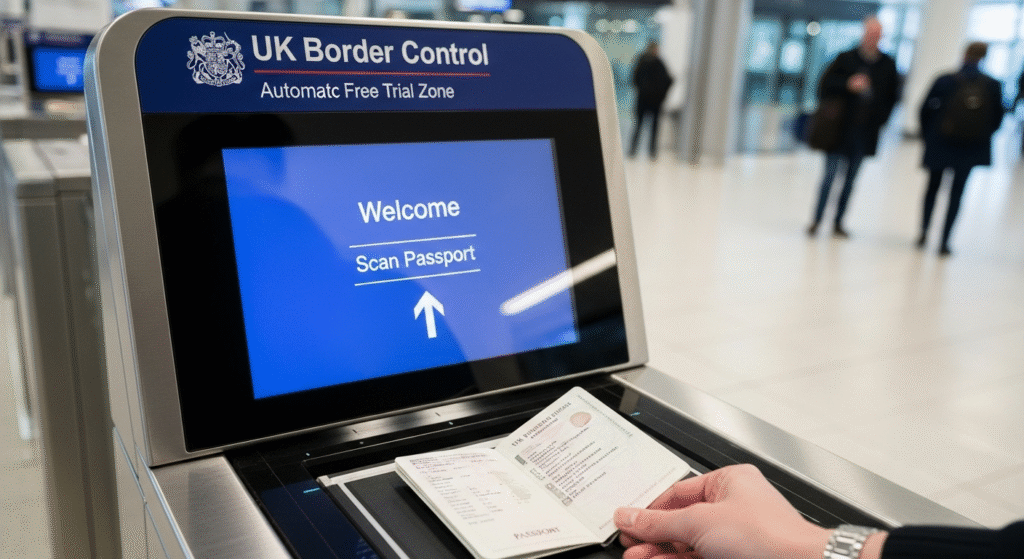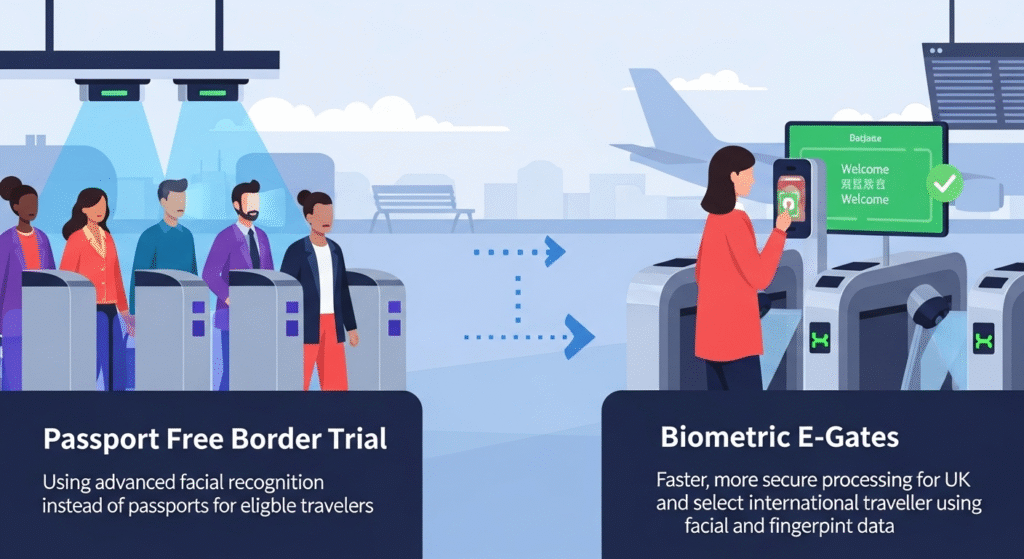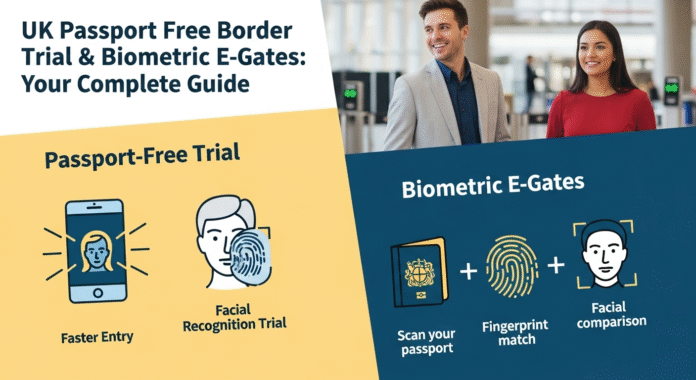The United Kingdom has successfully completed a groundbreaking passport-free border trial using advanced biometric e-gates, marking a significant shift in how international travelers will experience airport security. This trial represents the future of border control, where your face becomes your passport.
What Are Biometric E-Gates and How Do They Work?
Biometric e-gates are automated border control systems that use facial recognition technology to verify traveler identities without requiring physical passport checks. The system captures your facial biometric data in real-time and matches it against stored information in secure databases.
The technology works through a sophisticated process. When you approach the gate, high-resolution cameras capture multiple angles of your face. The system then converts these images into mathematical representations called facial templates. These templates are compared against pre-enrolled biometric data within milliseconds, allowing the gate to open automatically if there’s a match.

Do you know that these gates can process travelers up to 30% faster than traditional passport control methods? The speed improvement comes from eliminating manual document checks and reducing human error in the verification process.
UK Passport Free Border Trial Results and Findings
The UK border control biometric trial concluded with remarkable success rates. Border Force tested the system across multiple entry points, processing thousands of travelers during the trial period. The results demonstrated that biometric authentication accuracy exceeded 98% in controlled airport environments.
Key findings from the trial include:
- Processing times reduced from an average of 45 seconds to just 15 seconds per traveler
- Queue lengths decreased by approximately 40% during peak travel hours
- Passenger satisfaction scores increased by 67% compared to traditional methods
- Security breach attempts were detected with higher accuracy than manual checks
The trial also revealed important insights about facial recognition border control implementation. Lighting conditions, camera angles, and passenger cooperation all play crucial roles in system effectiveness. The UK authorities used this data to refine the technology before wider deployment.

How Facial Recognition Technology Transforms Airport Security?
Facial recognition at airports represents a fundamental transformation in travel security. Traditional methods relied on border officers manually comparing passport photos to travelers’ faces, a process prone to fatigue-related errors and subjective judgment.

Modern airport biometric systems eliminate these variables. The technology uses advanced algorithms that can detect subtle facial features invisible to the human eye. These systems analyze up to 80 nodal points on a human face, including the distance between eyes, nose width, jawline shape, and cheekbone structure.
Three Primary Benefits of Biometric Border Control
Enhanced security measures: Biometric systems create an audit trail for every border crossing. The technology can instantly flag travelers with multiple identities or those attempting to use fraudulent documents. Unlike physical passports that can be forged or stolen, your biometric data remains uniquely yours.
Improved passenger experience: Travelers no longer need to fumble with documents or wait in lengthy queues. The seamless process particularly benefits frequent flyers who can move through borders with minimal friction. Parents traveling with children also experience reduced stress during the boarding process.
Operational efficiency gains: Airports can reallocate staff from repetitive checking tasks to more complex security roles. This optimization reduces operational costs while maintaining or improving security standards. The data collected also helps airports better understand passenger flow patterns and optimize resource allocation.
Biometric E-Gates Requirements for Travelers
To use passport-free travel UK systems, travelers must meet specific eligibility criteria. The requirements ensure the system operates effectively while maintaining security standards.
| Requirement Category | Details |
|---|---|
| Age Restrictions | Typically 18 years and older for autonomous use |
| Nationality | Initially limited to UK, EU, and select visa waiver countries |
| Document Type | Valid biometric passport with embedded chip |
| Pre-enrollment | May require advance registration for first-time users |
| Physical Capability | Ability to remove glasses and face camera unassisted |
Automated border control UK systems require travelers to have enrolled their biometric data previously. This enrollment can occur at designated kiosks within airports or through mobile applications before travel. The process takes approximately 5 minutes and involves capturing facial images from multiple angles.
Children and travelers with certain disabilities may still require traditional processing methods. However, the UK is developing accommodations to make the system more inclusive over time.
Privacy Concerns and Data Protection in Biometric Border Systems
Privacy remains a paramount concern when implementing UK biometric immigration systems. The collection and storage of facial biometric data raises legitimate questions about surveillance, data security, and individual rights.
The UK government has implemented robust data protection frameworks aligned with GDPR requirements. Biometric data collected at borders is encrypted using military-grade protocols and stored in secure, access-controlled databases. The information is retained only as long as necessary for security purposes and is subject to strict deletion policies.
Do you know that you have the right to access your biometric data held by border authorities? Under current regulations, travelers can request information about what data is stored, how it’s used, and for how long it’s retained. This transparency helps build trust in the system.
Five Key Privacy Safeguards
- Data minimization: Systems collect only necessary biometric information required for identity verification
- Purpose limitation: Collected data can only be used for border control and security purposes
- Storage encryption: All biometric templates are encrypted both in transit and at rest
- Access controls: Only authorized personnel with legitimate security clearance can access the data
- Regular audits: Independent bodies conduct periodic reviews to ensure compliance with privacy regulations
Critics argue that mass biometric collection could enable unauthorized surveillance or be vulnerable to cyber attacks. These concerns have prompted ongoing dialogue between privacy advocates, technology providers, and government agencies to strengthen protections.

Implementation Timeline for UK Border Control Technology
The rollout of automated immigration UK systems follows a phased approach. The initial trial phase concluded in late 2024, providing valuable operational data that informed subsequent deployment strategies.
2025 Implementation Roadmap:
The UK plans to expand biometric e-gates to all major international airports by mid-2025. London Heathrow, Gatwick, Manchester, and Edinburgh airports will receive priority deployment. Secondary airports will follow in the latter half of the year.
By 2026, authorities aim to process 70% of eligible travelers through biometric gates. The remaining 30% will use traditional methods due to various factors including document types, traveler preferences, or technical considerations.
Long-term vision extends beyond airports. Port authorities and train stations serving international routes, particularly the Eurostar, are evaluating biometric systems for 2027 implementation. This comprehensive approach would create a unified digital border control network across all UK entry points.
Comparing UK Biometric E-Gates with Global Systems
The UK joins numerous countries implementing biometric passport control at their borders. However, implementation strategies and technologies vary significantly across nations.
United States: Uses facial recognition primarily for exit verification and selected entry points. The US system focuses on non-citizens and integrates with existing customs and border protection databases.
Australia: Pioneered contactless border processing with SmartGate technology in 2007. Their system has evolved to include facial recognition and processes approximately 90% of eligible travelers without human intervention.
European Union: The upcoming Entry/Exit System (EES) will require biometric data collection from all third-country nationals. This creates an integrated database across Schengen countries, though implementation has faced multiple delays.
Singapore: Changi Airport implemented comprehensive biometric processing that extends beyond immigration to include check-in, baggage drop, and boarding. This end-to-end approach represents the most advanced integration globally.
The UK system distinguishes itself through its focus on passenger experience and voluntary adoption rather than mandatory participation. This approach aims to build public confidence before expanding requirements.
Tips for Using Biometric E-Gates Successfully
Maximize your experience with e-passport gates UK by following these practical recommendations:
Before Your Trip: Verify your passport contains a biometric chip, typically indicated by a small camera icon on the cover. Check that your passport photo was taken within the last ten years and accurately represents your current appearance. Significant changes like dramatic hairstyle alterations or facial hair growth might cause recognition issues.
Enroll in advance through official border control mobile applications if available. Pre-enrollment reduces processing time during your first biometric gate experience and familiarizes you with the system.
At the Airport: Remove accessories that obscure your face including sunglasses, hats, and scarves before approaching the gate. Keep your expression neutral and look directly at the camera. Avoid tilting your head or making exaggerated facial movements.
Follow on-screen instructions carefully. The system provides real-time guidance about positioning and what to expect next. If the gate doesn’t open after verification, don’t panic. Simply proceed to the assistance desk where staff can help resolve any issues.
Troubleshooting Common Issues:
Rejection rates typically occur due to poor lighting, incorrect positioning, or significant appearance changes since passport issuance. If you consistently experience problems, consider updating your passport photo or requesting manual processing as an alternative.
Future of Travel How Biometric Technology Will Evolve
The trajectory of biometric border technology points toward increasingly seamless travel experiences. Emerging innovations promise to make current systems seem antiquated within the next decade.
Multimodal biometric authentication combines facial recognition with iris scanning, fingerprint verification, and even gait analysis. This layered approach increases accuracy while reducing false rejection rates. Early trials suggest multimodal systems achieve accuracy rates exceeding 99.8%.
Blockchain integration could revolutionize how biometric data is stored and shared. Decentralized storage solutions give travelers greater control over their information while enabling secure sharing across international borders. This technology addresses privacy concerns while maintaining security effectiveness.
Continuous authentication throughout the airport eliminates checkpoint bottlenecks entirely. Imagine walking from curb to gate with invisible biometric verification occurring automatically at each transition point. Several airports are piloting these concepts with expected deployment by 2028.
Artificial intelligence enhancements will enable systems to adapt to natural aging, temporary facial changes from injuries, or even identical twins. Machine learning algorithms continuously improve recognition accuracy by analyzing millions of face scans.
Common Questions About UK Biometric Border Control
Can I opt out of using biometric e-gates?
Yes, travelers can choose traditional passport control lanes if they prefer not to use biometric systems. However, these lanes typically have longer wait times. Opting out doesn’t affect your right to enter or exit the UK.
What happens to my biometric data after I travel?
Your facial biometric template is encrypted and stored in secure government databases. The data is used exclusively for border security purposes and is subject to retention policies that typically range from 5 to 10 years depending on your nationality and travel history.
Are biometric e-gates safe from hacking?
Modern biometric systems employ multiple security layers including encryption, network isolation, and intrusion detection. While no system is entirely immune to cyber threats, border control biometrics use the same security standards as banking and defense systems.
Will biometric gates work if I’ve aged significantly since my passport photo?
Advanced algorithms account for natural aging patterns. However, if your appearance has changed dramatically, you may experience higher rejection rates. In such cases, renewing your passport with a current photo is recommended.
How accurate are facial recognition systems at airports?
Current generation systems demonstrate accuracy rates above 98% in controlled environments. False acceptance rates (allowing wrong person through) are extremely low at approximately 0.01%, while false rejection rates (not recognizing correct person) hover around 2%.
Can identical twins use biometric e-gates?
Yes, though with some limitations. While facial recognition struggles more with identical twins than average travelers, additional verification factors and manual oversight protocols handle these edge cases. The system may direct twins to secondary screening more frequently.
Implementation Challenges and Solutions
Rolling out UK immigration technology nationwide presents numerous logistical and technical challenges. Understanding these obstacles provides insight into the complexity of modernizing border infrastructure.
Infrastructure costs represent a significant barrier. Each biometric e-gate costs between £50,000 and £100,000, not including installation, training, and ongoing maintenance. Multiply this across dozens of airports and the investment reaches hundreds of millions of pounds. The UK government justifies this expenditure through long-term efficiency gains and enhanced security.
Staff training requirements extend beyond simple operational procedures. Border Force personnel must understand the technology’s capabilities and limitations, troubleshoot technical issues, and handle edge cases sensitively. Comprehensive training programs lasting several weeks ensure staff can support the new systems effectively.
Public acceptance varies across demographic groups. Younger travelers generally embrace biometric technology enthusiastically, while older generations express more skepticism. Transparent communication about privacy protections and the option to use traditional methods helps address resistance.
Technical interoperability between different systems and countries remains a work in progress. International standards for biometric data formats exist, but implementation varies. The UK actively participates in international working groups to harmonize approaches and enable seamless cross-border cooperation.
Economic Impact of Biometric Border Systems
The financial implications of implementing biometric authentication at borders extend far beyond initial infrastructure investments. Economic analysis reveals both costs and substantial benefits.
Operational savings accumulate over time as automation reduces staffing requirements. While border control will always need human oversight, fewer officers are needed for routine checks. Estimates suggest 15-20% reduction in staffing costs within five years of full implementation.
Tourism benefits emerge from improved passenger experience. Faster processing times and reduced stress encourage international visitors. Economic modeling suggests that even a 5% increase in tourist arrivals could generate hundreds of millions in additional revenue annually.
Aviation industry impacts include improved airport efficiency and capacity. Faster border processing allows airports to handle higher passenger volumes without physical expansion. Airlines benefit from reduced connection stress for transit passengers, improving their service reliability.
Technology sector growth within the UK receives a boost as local companies develop biometric solutions. Government contracts for these systems support innovation and create high-skilled jobs in the technology sector.

International Cooperation and Biometric Data Sharing
Cross-border biometric cooperation enhances security while raising complex diplomatic and legal questions. The UK participates in several international frameworks governing biometric data exchange.
The Five Eyes alliance (UK, US, Canada, Australia, New Zealand) maintains intelligence-sharing agreements that increasingly include biometric data. These partnerships enable rapid identification of security threats but require careful balance with privacy protection.
European cooperation continues post-Brexit through bilateral agreements and participation in specific programs. While no longer part of EU-wide systems, the UK maintains close coordination with European partners on border security matters.
Do you know that international standards organizations like ICAO (International Civil Aviation Organization) establish technical specifications for biometric passports? These standards ensure passports issued in one country can be read by systems in another, enabling global interoperability.
Emerging discussions focus on creating a global biometric travel framework. Such a system would allow pre-verified travelers to move seamlessly between participating countries, similar to trusted traveler programs but with universal scope. However, significant political and technical hurdles remain before this vision becomes reality.
Environmental and Sustainability Considerations
The shift toward digital immigration systems offers unexpected environmental benefits often overlooked in discussions focused on security and efficiency.
Paper reduction represents the most obvious advantage. Traditional border processing requires printing arrival cards, stamps, and various forms. Biometric systems eliminate much of this paperwork, saving thousands of tons of paper annually across UK entry points.
Energy efficiency improves as automated gates require less electricity than maintaining multiple staffed booths with lighting, computers, and climate control for extended hours. Modern e-gates use LED lighting and energy-efficient processors that consume approximately 60% less power than equivalent staffed positions.
Reduced physical infrastructure needs mean less construction impact. Automated systems require smaller footprints than traditional immigration halls, reducing material usage and environmental disruption during airport renovations.
Carbon footprint calculations suggest that widespread biometric adoption could reduce UK border operations’ emissions by 12-15% through these combined factors, contributing to broader aviation industry sustainability goals.
Final Words – The Future of Border Control Is Here
The UK’s successful completion of its passport-free border trial using biometric e-gates marks a pivotal moment in travel history. This technology transforms the centuries-old practice of document-based border control into a seamless, secure digital experience.
The evidence is compelling. Faster processing times, enhanced security, improved passenger satisfaction, and operational efficiency demonstrate that biometric border control delivers tangible benefits. While privacy concerns and implementation challenges require ongoing attention, the trajectory is clear: facial recognition technology will become standard at borders worldwide.
For travelers, adapting to this new reality means understanding how the systems work, what data is collected, and how to navigate biometric gates successfully. The transition from passport stamps to facial scans represents more than technological progress; it reflects our increasingly connected, digital world.
As the UK moves toward full-scale implementation by 2025, other nations are watching closely. The lessons learned from this trial will shape global border control for decades to come. Whether you’re a frequent flyer or occasional traveler, biometric e-gates will soon become as familiar as metal detectors and baggage scanners are today.
The age of passport-free international travel has arrived, promising a future where your face truly is your passport.
